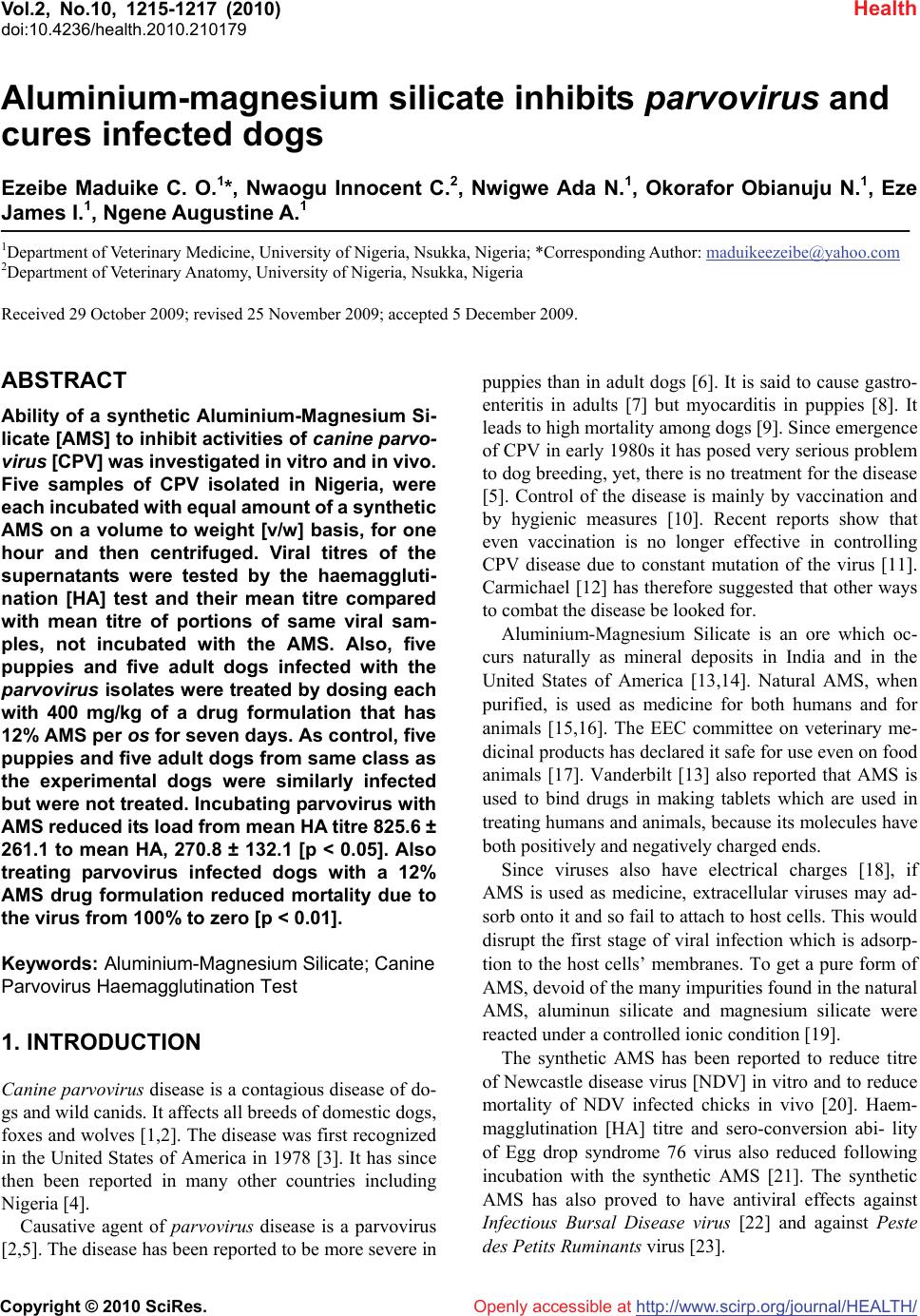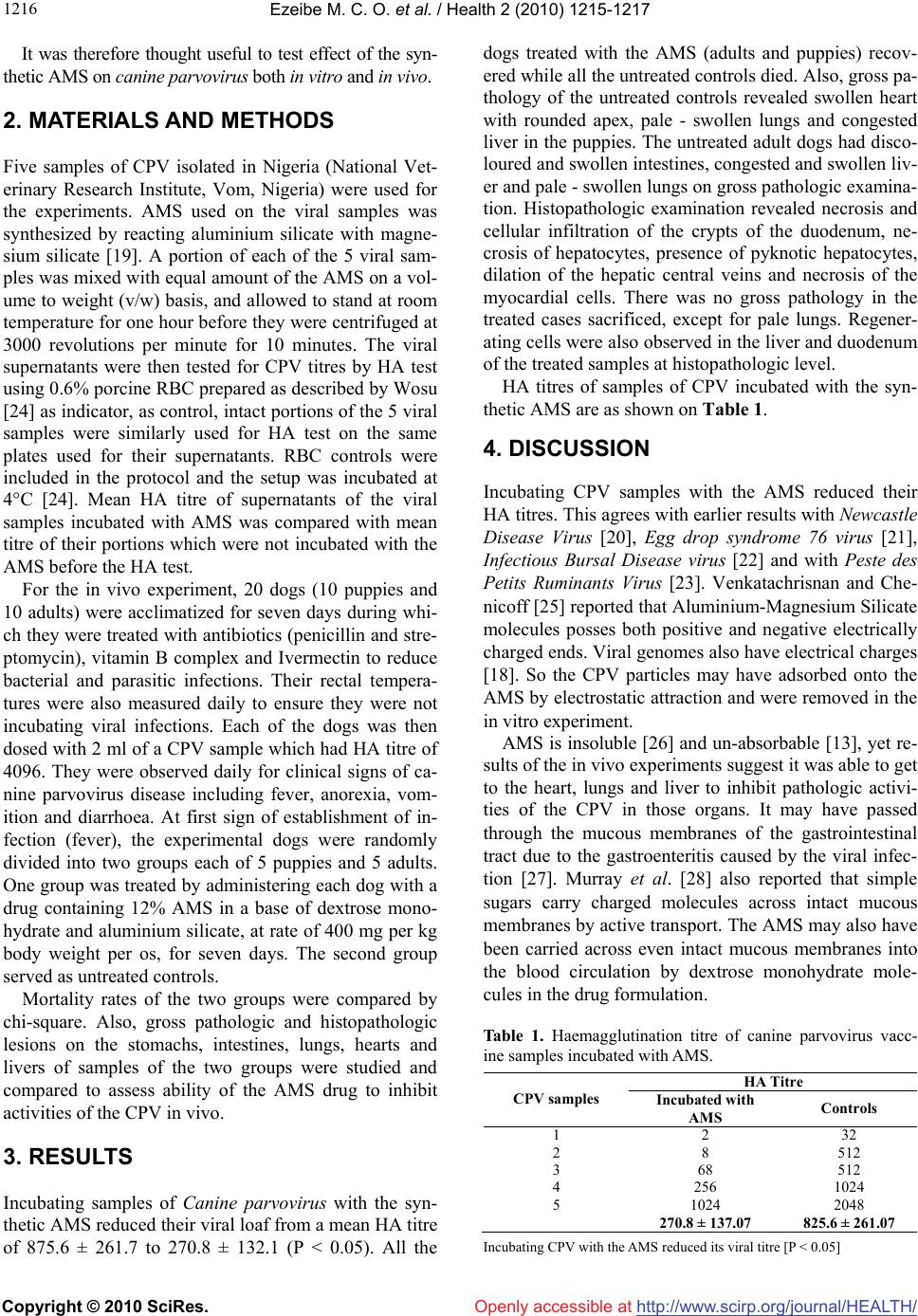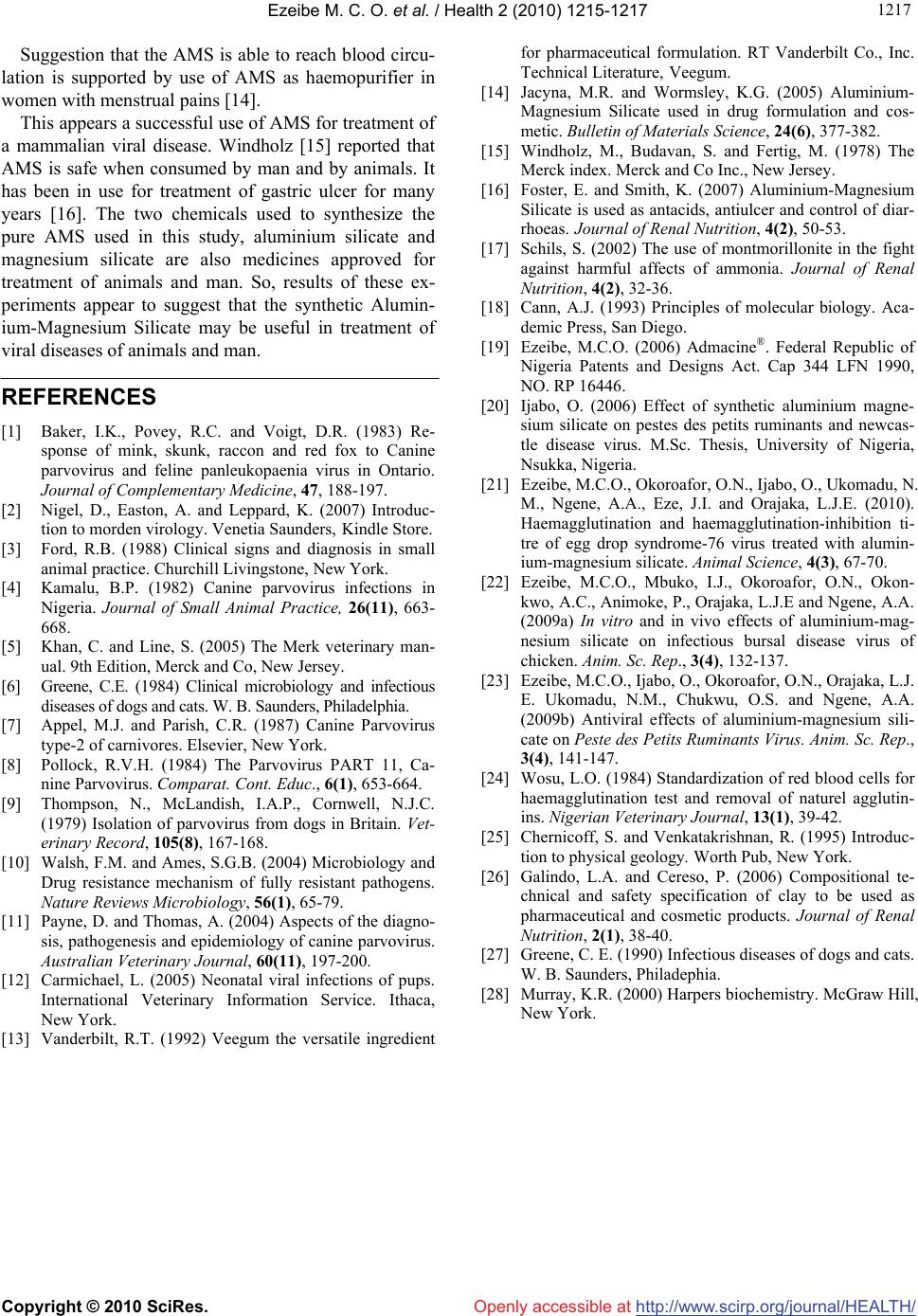Paper Menu >>
Journal Menu >>
 Vol.2, No.10, 1215-1217 (2010) Health doi:10.4236/health.2010.210179 Copyright © 2010 SciRes. Openly accessible at http://www.scirp.org/journal/HEALTH/ Aluminium-magnesium silicate inhibits parvovirus and cures infected dogs Ezeibe Maduike C. O.1*, Nwaogu Innocent C.2, Nwigwe Ada N.1, Okorafor Obianuju N.1, Eze James I.1, Ngene Augustine A.1 1Department of Veterinary Medicine, University of Nigeria, Nsukka, Nigeria; *Corresponding Author: maduikeezeibe@yahoo.com 2Department of Veterinary Anatomy, University of Nigeria, Nsukka, Nigeria Received 29 October 2009; revised 25 November 2009; accepted 5 December 2009. ABSTRACT Ability of a synthetic Aluminium-Magnesium Si- licate [AMS] to inhibit activities of canine parvo- virus [CPV] was investigated in vitro and in vivo. Five samples of CPV isolated in Nigeria, were each incubated with equal amount of a synthetic AMS on a volume to weight [v/w] basis, for one hour and then centrifuged. Viral titres of the supernatants were tested by the haemaggluti- nation [HA] test and their mean titre compared with mean titre of portions of same viral sam- ples, not incubated with the AMS. Also, five puppies and five adult dogs infected with the parvovirus isolates were treated by dosing each with 400 mg/kg of a drug formulation that has 12% AMS per os for seven days. As control, five puppies and five adult dogs from same class as the experimental dogs were similarly infected but were not treated. Incubating parvovirus with AMS reduced its load from mean HA titre 825.6 ± 261.1 to mean HA, 270.8 ± 132.1 [p < 0.05]. Also treating parvovirus infected dogs with a 12% AMS drug formulation reduced mortality due to the virus from 100% to zero [p < 0.01]. Keywords: Aluminium-Magnesium Silicate; Canine Parvovirus Haemagglutination Test 1. INTRODUCTION Canine parvovirus disease is a contagious disease of do- gs and wild canids. It affects all breeds of domestic dogs, foxes and wolves [1,2]. The disease was first recognized in the United States of America in 1978 [3]. It has since then been reported in many other countries including Nigeria [4]. Causative agent of parvovirus disease is a parvovirus [2,5]. The disease has been reported to be more severe in puppies than in adult dogs [6]. It is said to cause gastro- enteritis in adults [7] but myocarditis in puppies [8]. It leads to high mortality among dogs [9]. Since emergence of CPV in early 1980s it has posed very serious problem to dog breeding, yet, there is no treatment for the disease [5]. Control of the disease is mainly by vaccination and by hygienic measures [10]. Recent reports show that even vaccination is no longer effective in controlling CPV disease due to constant mutation of the virus [11]. Carmichael [12] has therefore suggested that other ways to combat the disease be looked for. Aluminium-Magnesium Silicate is an ore which oc- curs naturally as mineral deposits in India and in the United States of America [13,14]. Natural AMS, when purified, is used as medicine for both humans and for animals [15,16]. The EEC committee on veterinary me- dicinal products has declared it safe for use even on food animals [17]. Vanderbilt [13] also reported that AMS is used to bind drugs in making tablets which are used in treating humans and animals, because its molecules have both positively and negatively charged ends. Since viruses also have electrical charges [18], if AMS is used as medicine, extracellular viruses may ad- sorb onto it and so fail to attach to host cells. This would disrupt the first stage of viral infection which is adsorp- tion to the host cells’ membranes. To get a pure form of AMS, devoid of the many impurities found in the natural AMS, aluminun silicate and magnesium silicate were reacted under a controlled ionic condition [19]. The synthetic AMS has been reported to reduce titre of Newcastle disease virus [NDV] in vitro and to reduce mortality of NDV infected chicks in vivo [20]. Haem- magglutination [HA] titre and sero-conversion abi- lity of Egg drop syndrome 76 virus also reduced following incubation with the synthetic AMS [21]. The synthetic AMS has also proved to have antiviral effects against Infectious Bursal Disease virus [22] and against Peste des Petits Ruminants virus [23].  Ezeibe M. C. O. et al. / Health 2 (2010) 1215-1217 Copyright © 2010 SciRes. Openly accessible at http://www.scirp.org/journal/HEALTH/ 1216 It was therefore thought useful to test effect of the syn- thetic AMS on canine parvovirus both in vitro and in vivo. 2. MATERIALS AND METHODS Five samples of CPV isolated in Nigeria (National Vet- erinary Research Institute, Vom, Nigeria) were used for the experiments. AMS used on the viral samples was synthesized by reacting aluminium silicate with magne- sium silicate [19]. A portion of each of the 5 viral sam- ples was mixed with equal amount of the AMS on a vol- ume to weight (v/w) basis, and allowed to stand at room temperature for one hour before they were centrifuged at 3000 revolutions per minute for 10 minutes. The viral supernatants were then tested for CPV titres by HA test using 0.6% porcine RBC prepared as described by Wosu [24] as indicator, as control, intact portions of the 5 viral samples were similarly used for HA test on the same plates used for their supernatants. RBC controls were included in the protocol and the setup was incubated at 4°C [24]. Mean HA titre of supernatants of the viral samples incubated with AMS was compared with mean titre of their portions which were not incubated with the AMS before the HA test. For the in vivo experiment, 20 dogs (10 puppies and 10 adults) were acclimatized for seven days during whi- ch they were treated with antibiotics (penicillin and stre- ptomycin), vitamin B complex and Ivermectin to reduce bacterial and parasitic infections. Their rectal tempera- tures were also measured daily to ensure they were not incubating viral infections. Each of the dogs was then dosed with 2 ml of a CPV sample which had HA titre of 4096. They were observed daily for clinical signs of ca- nine parvovirus disease including fever, anorexia, vom- ition and diarrhoea. At first sign of establishment of in- fection (fever), the experimental dogs were randomly divided into two groups each of 5 puppies and 5 adults. One group was treated by administering each dog with a drug containing 12% AMS in a base of dextrose mono- hydrate and aluminium silicate, at rate of 400 mg per kg body weight per os, for seven days. The second group served as untreated controls. Mortality rates of the two groups were compared by chi-square. Also, gross pathologic and histopathologic lesions on the stomachs, intestines, lungs, hearts and livers of samples of the two groups were studied and compared to assess ability of the AMS drug to inhibit activities of the CPV in vivo. 3. RESULTS Incubating samples of Canine parvovirus with the syn- thetic AMS reduced their viral loaf from a mean HA titre of 875.6 ± 261.7 to 270.8 ± 132.1 (P < 0.05). All the dogs treated with the AMS (adults and puppies) recov- ered while all the untreated controls died. Also, gross pa- thology of the untreated controls revealed swollen heart with rounded apex, pale - swollen lungs and congested liver in the puppies. The untreated adult dogs had disco- loured and swollen intestines, congested and swollen liv- er and pale - swollen lungs on gross pathologic examina- tion. Histopathologic examination revealed necrosis and cellular infiltration of the crypts of the duodenum, ne- crosis of hepatocytes, presence of pyknotic hepatocytes, dilation of the hepatic central veins and necrosis of the myocardial cells. There was no gross pathology in the treated cases sacrificed, except for pale lungs. Regener- ating cells were also observed in the liver and duodenum of the treated samples at histopathologic level. HA titres of samples of CPV incubated with the syn- thetic AMS are as shown on Table 1. 4. DISCUSSION Incubating CPV samples with the AMS reduced their HA titres. This agrees with earlier results with Newcastle Disease Virus [20], Egg drop syndrome 76 virus [21], Infectious Bursal Disease virus [22] and with Peste des Petits Ruminants Virus [23]. Venkatachrisnan and Che- nicoff [25] reported that Aluminium-Magnesium Silicate molecules posses both positive and negative electrically charged ends. Viral genomes also have electrical charges [18]. So the CPV particles may have adsorbed onto the AMS by electrostatic attraction and were removed in the in vitro experiment. AMS is insoluble [26] and un-absorbable [13], yet re- sults of the in vivo experiments suggest it was able to get to the heart, lungs and liver to inhibit pathologic activi- ties of the CPV in those organs. It may have passed through the mucous membranes of the gastrointestinal tract due to the gastroenteritis caused by the viral infec- tion [27]. Murray et al. [28] also reported that simple sugars carry charged molecules across intact mucous membranes by active transport. The AMS may also have been carried across even intact mucous membranes into the blood circulation by dextrose monohydrate mole- cules in the drug formulation. Table 1. Haemagglutination titre of canine parvovirus vacc- ine samples incubated with AMS. HA Titre CPV samples Incubated with AMS Controls 1 2 32 2 8 512 3 68 512 4 256 1024 5 1024 2048 270.8 ± 137.07 825.6 ± 261.07 Incubating CPV with the AMS reduced its viral titre [P < 0.05]  Ezeibe M. C. O. et al. / Health 2 (2010) 1215-1217 Copyright © 2010 SciRes. Openly accessible at http://www.scirp.org/journal/HEALTH/ 121 1217 Suggestion that the AMS is able to reach blood circu- lation is supported by use of AMS as haemopurifier in women with menstrual pains [14]. This appears a successful use of AMS for treatment of a mammalian viral disease. Windholz [15] reported that AMS is safe when consumed by man and by animals. It has been in use for treatment of gastric ulcer for many years [16]. The two chemicals used to synthesize the pure AMS used in this study, aluminium silicate and magnesium silicate are also medicines approved for treatment of animals and man. So, results of these ex- periments appear to suggest that the synthetic Alumin- ium-Magnesium Silicate may be useful in treatment of viral diseases of animals and man. REFERENCES [1] Baker, I.K., Povey, R.C. and Voigt, D.R. (1983) Re- sponse of mink, skunk, raccon and red fox to Canine parvovirus and feline panleukopaenia virus in Ontario. Journal of Complementary Medicine, 47, 188-197. [2] Nigel, D., Easton, A. and Leppard, K. (2007) Introduc- tion to morden virology. Venetia Saunders, Kindle Store. [3] Ford, R.B. (1988) Clinical signs and diagnosis in small animal practice. Churchill Livingstone, New York. [4] Kamalu, B.P. (1982) Canine parvovirus infections in Nigeria. Journal of Small Animal Practice, 26(11), 663- 668. [5] Khan, C. and Line, S. (2005) The Merk veterinary man- ual. 9th Edition, Merck and Co, New Jersey. [6] Greene, C.E. (1984) Clinical microbiology and infectious diseases of dogs and cats. W. B. Saunders, Philadelphia. [7] Appel, M.J. and Parish, C.R. (1987) Canine Parvovirus type-2 of carnivores. Elsevier, New York. [8] Pollock, R.V.H. (1984) The Parvovirus PART 11, Ca- nine Parvovirus. Comparat. Cont. Educ., 6(1), 653-664. [9] Thompson, N., McLandish, I.A.P., Cornwell, N.J.C. (1979) Isolation of parvovirus from dogs in Britain. Vet- erinary Record, 105(8), 167-168. [10] Walsh, F.M. and Ames, S.G.B. (2004) Microbiology and Drug resistance mechanism of fully resistant pathogens. Nature Reviews Microbiology, 56(1), 65-79. [11] Payne, D. and Thomas, A. (2004) Aspects of the diagno- sis, pathogenesis and epidemiology of canine parvovirus. Australian Veterinary Journal, 60(11), 197-200. [12] Carmichael, L. (2005) Neonatal viral infections of pups. International Veterinary Information Service. Ithaca, New York. [13] Vanderbilt, R.T. (1992) Veegum the versatile ingredient for pharmaceutical formulation. RT Vanderbilt Co., Inc. Technical Literature, Veegum. [14] Jacyna, M.R. and Wormsley, K.G. (2005) Aluminium- Magnesium Silicate used in drug formulation and cos- metic. Bulletin of Materials Science, 24(6), 377-382. [15] Windholz, M., Budavan, S. and Fertig, M. (1978) The Merck index. Merck and Co Inc., New Jersey. [16] Foster, E. and Smith, K. (2007) Aluminium-Magnesium Silicate is used as antacids, antiulcer and control of diar- rhoeas. Journal of Renal Nutrition, 4(2), 50-53. [17] Schils, S. (2002) The use of montmorillonite in the fight against harmful affects of ammonia. Journal of Renal Nutrition, 4(2), 32-36. [18] Cann, A.J. (1993) Principles of molecular biology. Aca- demic Press, San Diego. [19] Ezeibe, M.C.O. (2006) Admacine®. Federal Republic of Nigeria Patents and Designs Act. Cap 344 LFN 1990, NO. RP 16446. [20] Ijabo, O. (2006) Effect of synthetic aluminium magne- sium silicate on pestes des petits ruminants and newcas- tle disease virus. M.Sc. Thesis, University of Nigeria, Nsukka, Nigeria. [21] Ezeibe, M.C.O., Okoroafor, O.N., Ijabo, O., Ukomadu, N. M., Ngene, A.A., Eze, J.I. and Orajaka, L.J.E. (2010). Haemagglutination and haemagglutination-inhibition ti- tre of egg drop syndrome-76 virus treated with alumin- ium-magnesium silicate. Animal Science, 4(3), 67-70. [22] Ezeibe, M.C.O., Mbuko, I.J., Okoroafor, O.N., Okon- kwo, A.C., Animoke, P., Orajaka, L.J.E and Ngene, A.A. (2009a) In vitro and in vivo effects of aluminium-mag- nesium silicate on infectious bursal disease virus of chicken. Anim. Sc. Rep., 3(4), 132-137. [23] Ezeibe, M.C.O., Ijabo, O., Okoroafor, O.N., Orajaka, L.J. E. Ukomadu, N.M., Chukwu, O.S. and Ngene, A.A. (2009b) Antiviral effects of aluminium-magnesium sili- cate on Peste des Petits Ruminants Virus. Anim. Sc. Rep., 3(4), 141-147. [24] Wosu, L.O. (1984) Standardization of red blood cells for haemagglutination test and removal of naturel agglutin- ins. Nigerian Veterinary Journal, 13(1), 39-42. [25] Chernicoff, S. and Venkatakrishnan, R. (1995) Introduc- tion to physical geology. Worth Pub, New York. [26] Galindo, L.A. and Cereso, P. (2006) Compositional te- chnical and safety specification of clay to be used as pharmaceutical and cosmetic products. Journal of Renal Nutrition, 2(1), 38-40. [27] Greene, C. E. (1990) Infectious diseases of dogs and cats. W. B. Saunders, Philadephia. [28] Murray, K.R. (2000) Harpers biochemistry. McGraw Hill, New York. |

